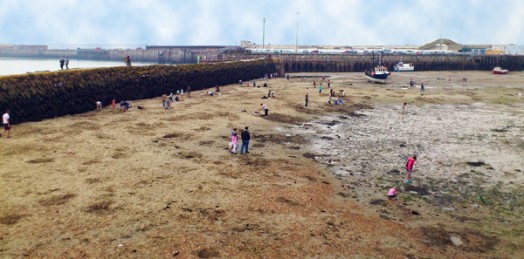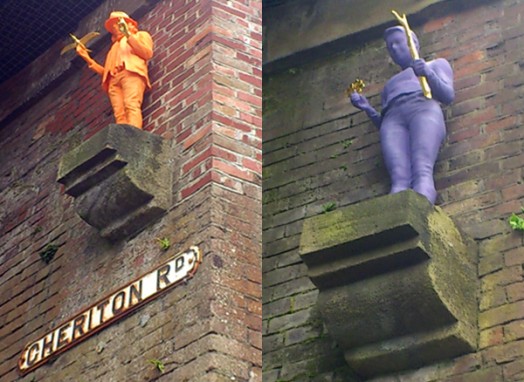September 11, 2014
One week after its official launch on 30th August, Folkestone Triennial is still drawing in the map-clutching visitors. The event hit the local and national headlines and caused a storm on social media in the opening weekend when ‘Gold Rush’ fever swept through the town. Folkestone’s residents and visitors alike flocked to the outer harbour beach to dig for gold buried by Berlin-based artist, Michael Sailstorfer. For his artwork, entitled Folkestone Digs, Sailstorfer hid 30 pieces of 24-carat gold beneath the sand, and the small section of beach has rarely been empty since, with only high tide and nightfall holding the spade-wielding treasure hunters at bay.

Every three years Folkestone, a seaside town on the South-coast of the UK where our Noted In Style office is based, becomes, for a couple of months, an interactive, open air art gallery. The event is one of the projects run by the Creative Foundation, an independent arts charity with a passion for bringing about the regeneration of the town through creative activity. And with 2014’s theme of The Lookout, that regeneration is at the forefront with the artworks encouraging visitors to look out across the town’s past and present in order to consider its future. The Wind Lift by Marjectica Potrc and Ooze Architects does this by raising its occupants to the top of the Foord Road Viaduct in a wind powered lift. Completed in 1844, the Foord Viaduct played an important role in bringing Folkestone into the modern age, enabling the town to prosper. It’s fitting, then, to stand on the shaky lift with the railway behind you, while you look out across views of Folkestone’s Creative Quarter and harbour both with their link to the town’s cultural renewal.
With artists invited to utilise Folkestone’s open spaces, many of which are derelict or wasteland sites, it’s interesting to glimpse the town’s nooks and crannies we might not normally see, and to venture down streets we wouldn’t normally walk. The art trail has a natural starting point at Folkestone Central Station with a piece by Yoko Ono. But it’s Strange Cargo’s The Luckiest Place on Earth exhibit, where four vibrant figures stand on plinths within Folkestone Central Railway Bridge, that acts as what is described as a ‘Lucky Gateway’ to the town. Each sculpture, in a colour associated with luck, is a 3D printed model of a person clasping a lucky golden charm. The sculptures are intended to make people think about how lucky they feel and how we can move forward. And they brighten up an otherwise gloomy part of town.

Linked to this piece, the Lucky Me! exhibition at the St George’s Gallery gives visitors the opportunity to have miniature sculptures, just like the full sized ones under the railway bridge, made of themselves. The process is surprisingly quick and simple and begins with a person standing on a plinth where they are scanned by a low power laser. This laser captures the individual’s 3D geometry and surface texture, and the data is then edited to remove anything unwanted, such as the plinth and the background. Next the image is sculpted – like 3D clay – to remove any unwanted lumps and bumps, until a faithful representation is achieved. The data is now ready to print.
You can stand and watch as the 3D sculptures are printed. They are produced out of Polylactic acid, or PLA, but the machine can print in any solid to liquid to solid material. The machine needs to print a scaffolding to support any protruding parts of the sculpture as it evolves, such as arms and edges of clothing, and at the end of the process, approx 40 minutes to one hour, the scaffolding is cut away to reveal a miniature 3D figure. The machine at the gallery can only print one colour, but any colour can be used to create a bright and cheerful end result.
What is fascinating with this technology is the potential for collaborative work between the printer and, for example, artists or architects. An artist’s sketch can become an intricate piece of 3D art in almost any material from paper to titanium metal; even gold or silver can be used, with jewellery designers able to create interesting one off pieces.
As a creative business, we can’t think of a better place to be based than in a creative town, especially at such an exciting phase in its regeneration. The 2014 Folkestone Triennial runs until 2nd November and is open daily from 10am to 5pm.

